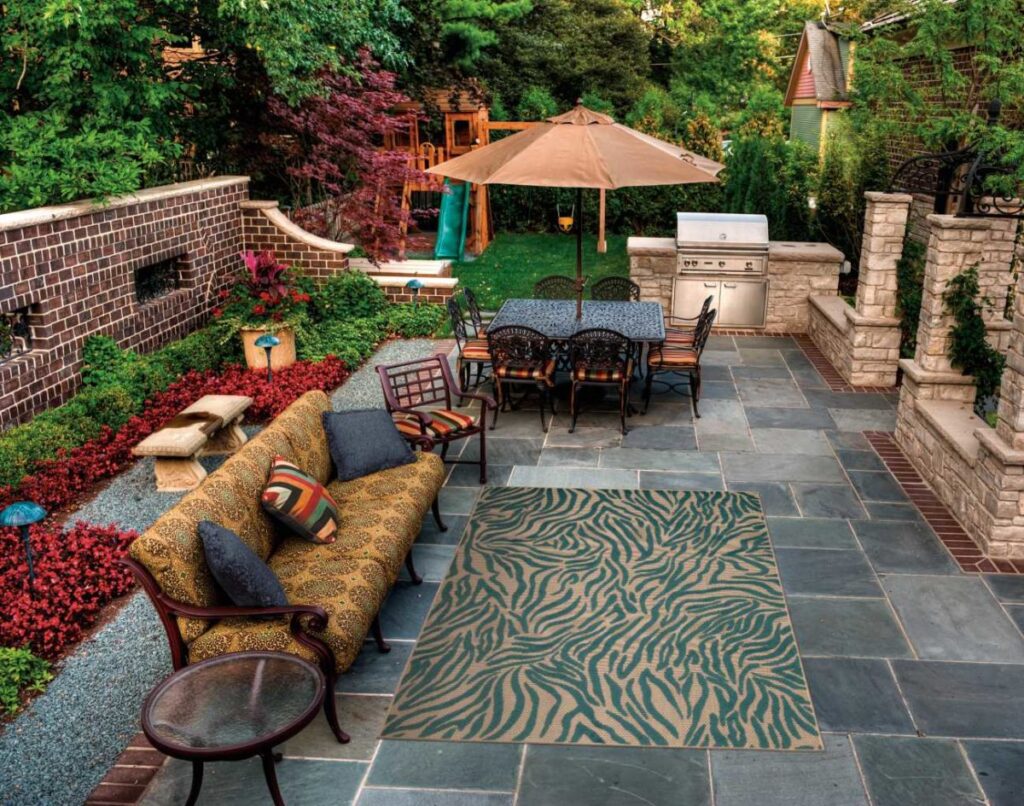What is an outdoor rug?
An outdoor rug is a rug specifically designed to withstand the harsh outdoor conditions, such as weather changes, rain, snow, sunlight, and other outdoor elements that can cause damage to regular indoor rugs. These rugs are typically made from synthetic materials like polypropylene, which is a sturdy and durable fiber that can resist fading and staining. However, some outdoor rugs can also be made with natural fibers like jute or sisal, which can provide a more organic look and feel to your outdoor space.
Outdoor rugs come in a wide range of sizes, styles, and colors to match any outdoor decor, and they can be used on many different surfaces, including wooden decks, concrete patios, and composite decking. By adding an outdoor rug to your outdoor living space, you can create an inviting and comfortable atmosphere that adds warmth and texture to your outdoor décor while protecting your patio or deck from potential damage.
Benefits of having an outdoor rug
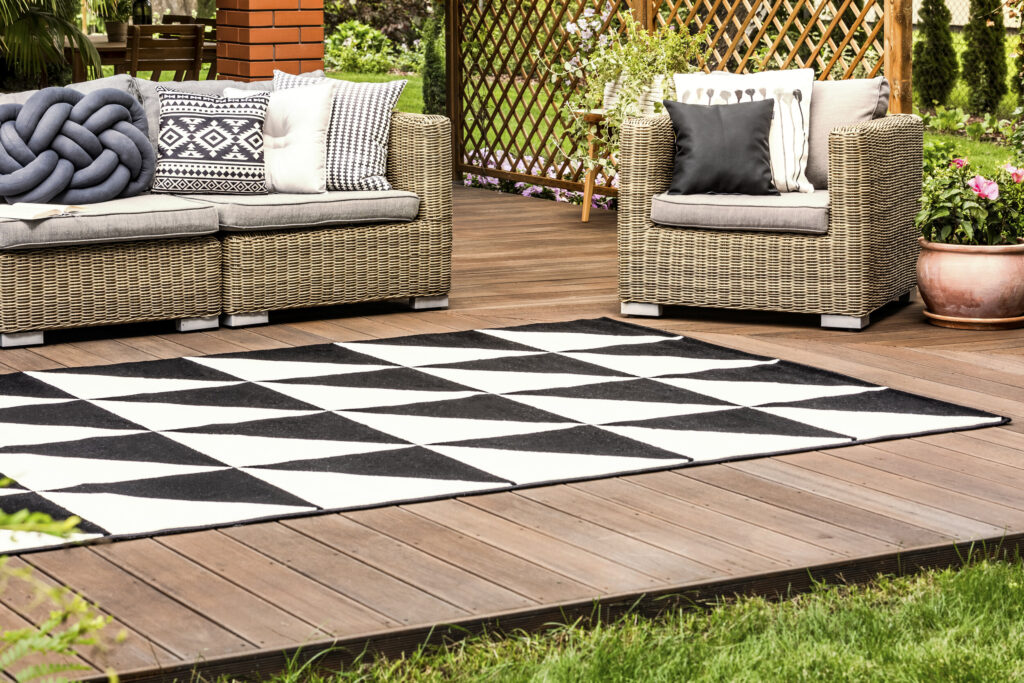
Adding an outdoor rug to your patio or outdoor living space can provide a variety of benefits. Not only will it add a pop of color and texture to your design, but it can also serve as a protective layer for your outdoor space and furniture.
One of the main benefits of having an outdoor rug is the way it can define your space. If you have a large outdoor living area, an outdoor rug can help to create different sections for seating and dining. This can make your space feel more organized and inviting.
Additionally, outdoor rugs can protect your patio surface or wooden deck from wear and tear. Without a rug, furniture and foot traffic can cause damage to the surface, which can be costly to repair. Outdoor rugs offer a layer of protection and can help extend the life of your outdoor living space.
Outdoor rugs also have the benefit of making your outdoor space feel more comfortable and cozy. Soft fibers, such as natural and synthetic materials alike, can be welcoming to bare feet, while also helping to absorb excess water and preventing mildew growth.
Another benefit to having an outdoor rug is the way it can tie your decor together. Choose a rug that complements your outdoor furniture and accessories, helping create a cohesive look. Even if your furniture is mismatched, an outdoor rug can pull everything together.
Overall, investing in an outdoor rug can have a positive impact on your outdoor living space. From defining areas to providing protection and comfort, a rug is a versatile addition that enhances the look and functionality of your patio or deck. Just be sure to choose a rug that is suitable for outdoor conditions, using materials such as polypropylene or recycled plastic mats, and regularly clean it with a mild detergent like dish soap to avoid unsightly stains and signs of damage from severe weather conditions.
Types of Outdoor Rugs
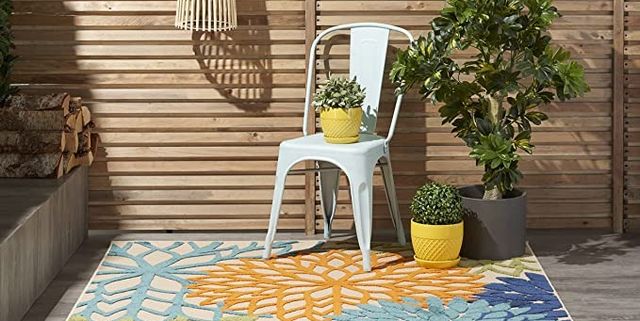
When it comes to choosing an outdoor rug for your patio or deck, there are a variety of options to consider. From natural materials to synthetic materials, there are different types of outdoor rugs that can meet your specific needs and preferences.
One popular type of outdoor rug is made from natural fibers such as jute, sisal, and bamboo. These rugs are often woven by hand, and their natural texture can add a rustic and earthy feel to your outdoor living space. However, it’s worth noting that natural fiber rugs may not be as durable as synthetic materials and may require more maintenance to prevent mildew growth.
Synthetic fiber rugs are another popular choice for outdoor spaces. They’re typically made from materials like polypropylene or recycled plastic, which can withstand harsh weather conditions and excessive wear and tear without fading or becoming damaged. These rugs come in a wide range of colors and patterns, making it easy to find one that complements your outdoor furniture and decor.
Another option to consider is a rug made from a blend of natural and synthetic fibers. These rugs combine the softness and texture of natural materials with the durability and weather-resistance of synthetic fibers. They can be a good compromise for those who want the best of both worlds.
When choosing an outdoor rug, it’s also important to consider the size and shape that will work best for your space. Consider the size of your patio or deck, as well as the placement of your furniture, to determine the best dimensions for your rug. You may want to choose a rug that’s slightly larger than your furniture arrangement to create a defined seating or dining area.
Overall, there are many types of outdoor rugs to choose from, each with its own pros and cons. Consider your specific needs and preferences when selecting a rug for your outdoor living space, and you’re sure to find one that adds both style and functionality to your patio or deck.
Natural Fiber Rugs
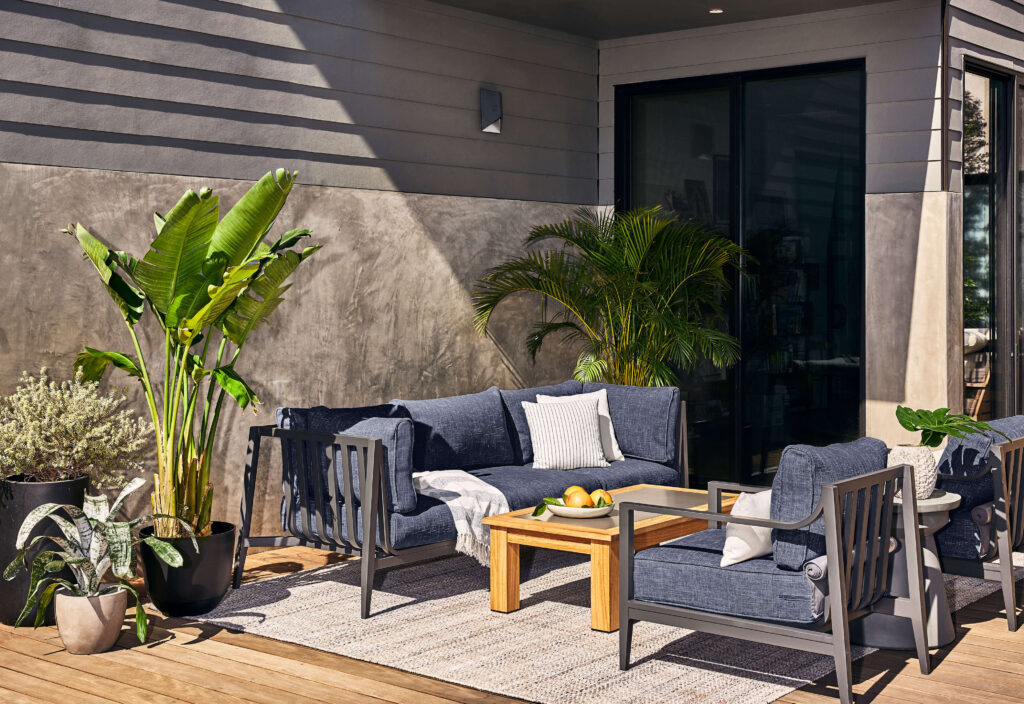
Natural fiber rugs, such as those made from jute, sisal, and bamboo, have become increasingly popular in recent years as more and more people seek to add a natural, earthy feel to their outdoor living spaces. These rugs offer a unique texture and appearance that can’t be replicated by synthetic materials, and they can be a great option for those who want to create a warm and inviting atmosphere in their outdoor areas.
One of the benefits of natural fiber rugs is their durability. While they may not be as weather-resistant as synthetic materials, these rugs are typically quite sturdy and can withstand the wear and tear of regular use. They’re also less likely to show signs of wear, such as matting or fraying, which can be common with synthetic fibers.
Another advantage of natural fiber rugs is that they’re often more environmentally friendly than synthetic materials. Many of these rugs are made from sustainable resources, which means that they have a lower carbon footprint than carpets produced from synthetic materials. Additionally, they tend to be biodegradable, which means they won’t contribute to the buildup of waste in landfills.
However, it’s worth noting that natural fiber rugs do require some special care to keep them looking their best. One of the biggest concerns with these rugs is the potential for mildew growth. Because natural fibers absorb moisture more readily than synthetic materials, they can become breeding grounds for mildew if they’re exposed to excessive moisture. To prevent this, it’s important to regularly clean your rug and allow it to fully dry after rain or heavy use.
In addition to mildew, natural fiber rugs can also be prone to staining. Because the fibers are absorbent, they may soak up spills and stains more readily than a synthetic rug would. To prevent this, it’s important to clean up any spills as soon as possible and to avoid using harsh chemicals or detergents when cleaning your rug.
Despite these potential issues, many people find that natural fiber rugs are a beautiful and worthwhile addition to their outdoor spaces. These rugs can add warmth and texture to a patio or deck, and their unique look can create an inviting and cozy atmosphere for outdoor gatherings and relaxation. Whether you choose jute, sisal, bamboo, or another natural fiber, a well-maintained rug can be a lovely and functional accent to your outdoor living space.
Synthetic Material Rugs
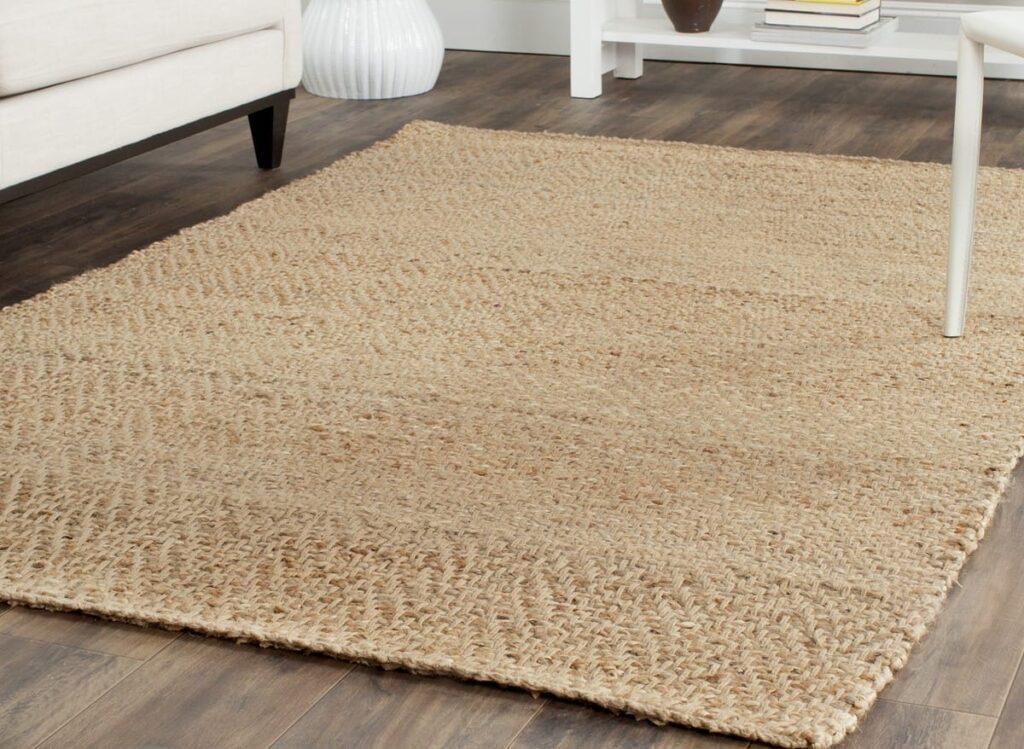
Synthetic material rugs have become increasingly popular for outdoor use due to their ability to withstand harsh weather conditions. Made from man-made fibers such as polypropylene, these rugs are designed to hold up against moisture, heat, and sunlight, making them ideal for use on decks, patios, and other outdoor living spaces.
One of the biggest advantages of synthetic material rugs is their resistance to water damage. Unlike natural fibers, which can absorb moisture and become breeding grounds for mildew, synthetic materials are designed to repel water, preventing excess moisture from collecting and causing damage to your flooring or deck surface. This makes them an excellent choice for use in uncovered outdoor areas where rain or other inclement weather conditions are a concern.
Another benefit of using synthetic material rugs is their durability. Made from tough and durable fibers, these rugs are designed to withstand regular use without showing signs of wear or tear. They’re also resistant to fading, which means they won’t lose their color or texture over time, even when exposed to direct sunlight.
In addition to their practical benefits, synthetic material rugs are also available in a wide range of styles and designs, making them a versatile choice for any outdoor living space. Whether you’re looking for a rug to complement your outdoor furniture or add some texture to your wooden deck, you’re sure to find a synthetic material rug that meets your needs.
When it comes to maintaining your synthetic material rug, it’s important to keep up with regular cleaning to prevent dirt, dust, and debris from accumulating. Simply use a soft-bristled brush or vacuum to remove any loose dirt or debris, and then clean your rug with soapy water and a gentle dish soap solution. Avoid using a carpet cleaner or any harsh chemicals, as these can damage the fibers of your rug and shorten its lifespan.
Overall, synthetic material rugs are an excellent choice for anyone looking to add a layer of protection and style to their outdoor living space. Whether you’re dealing with harsh weather conditions or just looking to add some texture and color to your patio or deck, a synthetic material rug is a durable and practical choice that’s sure to provide years of use and enjoyment.
Organic Materials Rugs
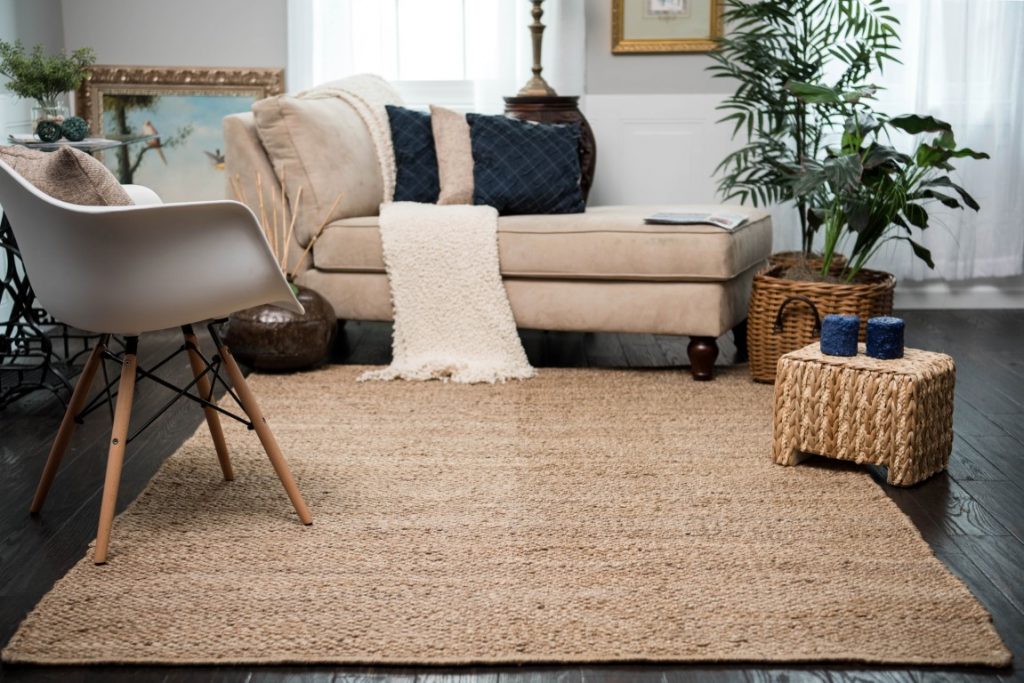
Organic materials rugs have become increasingly popular in recent years due to their natural and eco-friendly properties. Made from materials like wool, jute, sisal, and hemp, these rugs are free from synthetic chemicals and are biodegradable, making them a sustainable choice for your home decor.
One of the greatest benefits of organic materials rugs is their ability to add texture and warmth to indoor and outdoor spaces. The natural fibers used in these rugs create a tactile feel underfoot, adding a cozy and inviting element to any room. They’re also versatile in terms of design, as they come in a variety of colors and patterns that work well with virtually any decor style.
Another advantage of organic materials rugs is their durability. Wool rugs, for example, are known for their long lifespan as they are resistant to wear-and-tear. Sisal and jute rugs are also sturdy and can be used in high-traffic areas, amplifying durability when used with a rug pad.
However, there are some downsides to organic materials rugs. For one, organic materials can be more prone to staining, so it’s important to clean up spills quickly to avoid permanent damage. These rugs are also more susceptible to mildew growth if they’re exposed to excess moisture, so it’s important to keep them dry and well-ventilated.
To maintain organic materials rugs, regular vacuuming is essential, as this will remove any dirt and debris that may become trapped in the fibers. Depending on the type of material, you can also use a soft-bristled brush to remove any stubborn dirt or stains. Spot cleaning with a gentle cleaning solution is ideal for removing spills or stains.
Overall, organic materials rugs are an excellent choice for those looking to create a more sustainable and natural living environment. While they may require a bit more care and maintenance than synthetic rugs, their durability, texture, and eco-friendly properties make them a worthwhile investment.
Carpet Tapes for Rug Installation

Carpet tapes have become a popular tool to secure rugs in place while preventing slipping and shifting. These adhesive tapes are easy to use, requiring no special tools or skills to install. They can be used to secure a rug onto any surface, whether it’s a hardwood floor, carpet, or tile.
When searching for the right carpet tape, it’s important to consider the surface you’ll be using it on. Some tapes are specially designed for hardwood floors, while others work better on carpet or tiles. It’s also essential to check if the tape is suited for outdoor usage if you’re looking to install a rug in your outdoor patio or deck.
One of the main advantages of using carpet tapes is that they offer a no-slip solution, making it safer to walk or run on a rug. They are also affordable, making it a cost-effective alternative to rug pads. Unlike rug pads, carpet tapes won’t add any cushioning, but they are effective in holding the rug in place.
Another benefit of using carpet tapes is that they offer a clean and seamless look since they are virtually invisible under the rug. With rug pads, there might be some visible bulges or bumps under the rug, which can be unsightly.
Carpet tapes are also easy to remove and don’t leave any sticky residue behind, making it hassle-free to replace or reposition rugs in the future.
Overall, if you’re looking for an affordable and easy way to secure your rugs in place, carpet tapes are worth considering. Just make sure to choose the right type of tape for your surface and follow the manufacturer’s instructions for proper installation. With carpet tapes, you can enjoy the beauty and functionality of your rug without worrying about slipping or shifting.
Advantages and Disadvantages of Having Outdoor Rugs on Your Patio
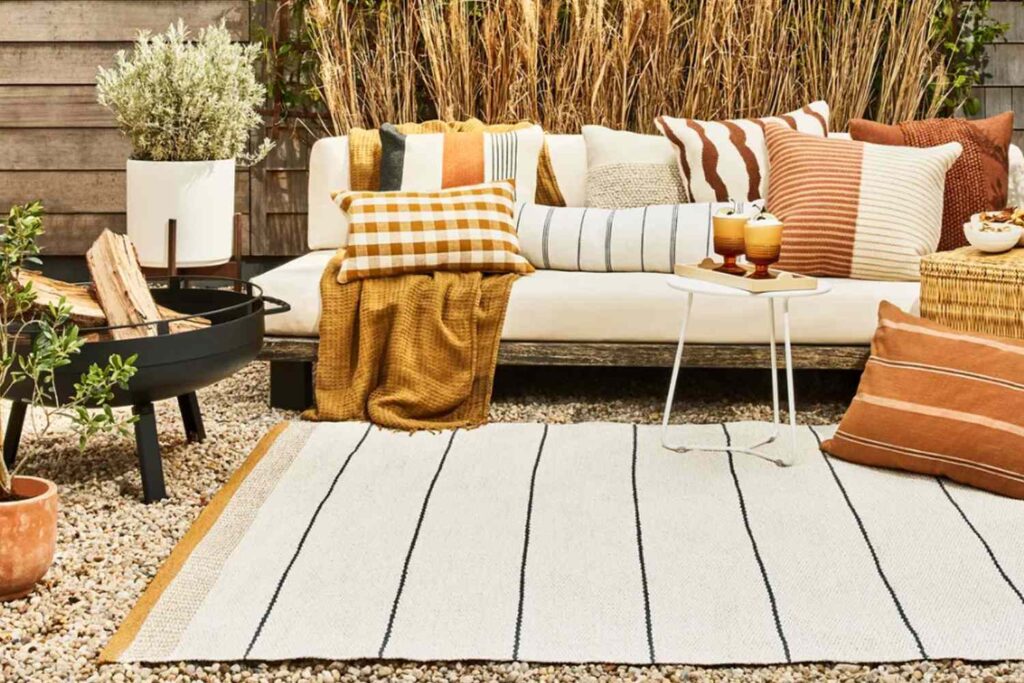
An outdoor rug can be a great addition to your patio, adding a layer of texture and comfort to the space. However, before investing in one, it’s important to weigh the advantages and disadvantages:
Advantages:
1. Aesthetic appeal: Outdoor rugs come in a variety of colors, patterns, and designs that can enhance the overall look and feel of your outdoor space.
2. Soft underfoot: Walking on an outdoor rug can feel comfortable and soft, especially when compared to hard concrete or wooden surfaces.
3. Protection: An outdoor rug can protect your patio surface from scratches and scuffs caused by outdoor furniture or foot traffic.
4. Non-slip: Outdoor rugs are often made with non-slip materials, which can prevent accidents caused by slippery surfaces.
5. Low maintenance: Most outdoor rugs are easy to clean with just a bit of soapy water, making them a low-maintenance addition to your patio.
Disadvantages:
1. Water damage: An outdoor rug can become a breeding ground for mildew growth if it becomes wet and stays wet for too long. This can happen if the rug is placed on a concrete surface or an uncovered patio.
2. Potential damage to patio surfaces: Outdoor rugs can trap excess water underneath, which can cause damage to wooden decking, composite decks, or other organic materials.
3. Harsh weather conditions: Severe weather conditions like heavy rain, snow, or hail can cause damage to the rug, making it necessary to replace it more frequently.
4. Unsightly stains: Even with regular cleaning, outdoor rugs are more likely to accumulate stains caused by sun damage, spilled drinks, or accidental food spills.
5. Added cost: Outdoor rugs can be costly, especially if you opt for a natural fiber rug. Additionally, you may need to purchase a rug pad to prevent the rug from slipping or molding.
Before investing in an outdoor rug, carefully weigh the pros and cons to ensure it’s the best choice for your patio and lifestyle.
Advantages
Outdoor rugs can be the perfect addition to any outdoor space, providing both functional and aesthetic benefits. One of the main advantages of an outdoor rug is the aesthetic appeal it can bring to your outdoor living space. With a variety of colors, patterns, and designs available, there is an outdoor rug to suit any style or taste. Whether you want to make a bold statement with a bright and colorful rug, or create a subtle and sophisticated look with a neutral-toned rug, there are plenty of options to choose from.
In addition to their visual appeal, outdoor rugs offer practical benefits as well. For example, an outdoor rug is soft underfoot, making it a comfortable surface to walk on. This can be especially beneficial if your outdoor space features hard surfaces like concrete or wood. An outdoor rug can also provide a layer of protection for your patio surface by preventing scratches and scuffs caused by outdoor furniture or foot traffic.
Another advantage of outdoor rugs is that they are often made with non-slip materials, which can prevent accidents caused by slippery surfaces. This can be particularly important if you have children or elderly individuals in your home who may be more prone to slip and fall accidents.
Finally, outdoor rugs are generally low maintenance and easy to clean. Most can be cleaned with just a bit of soapy water, making them a convenient addition to your outdoor space. With all of these advantages, it’s easy to see why an outdoor rug can be a smart investment for any homeowner looking to enhance their outdoor living space.

